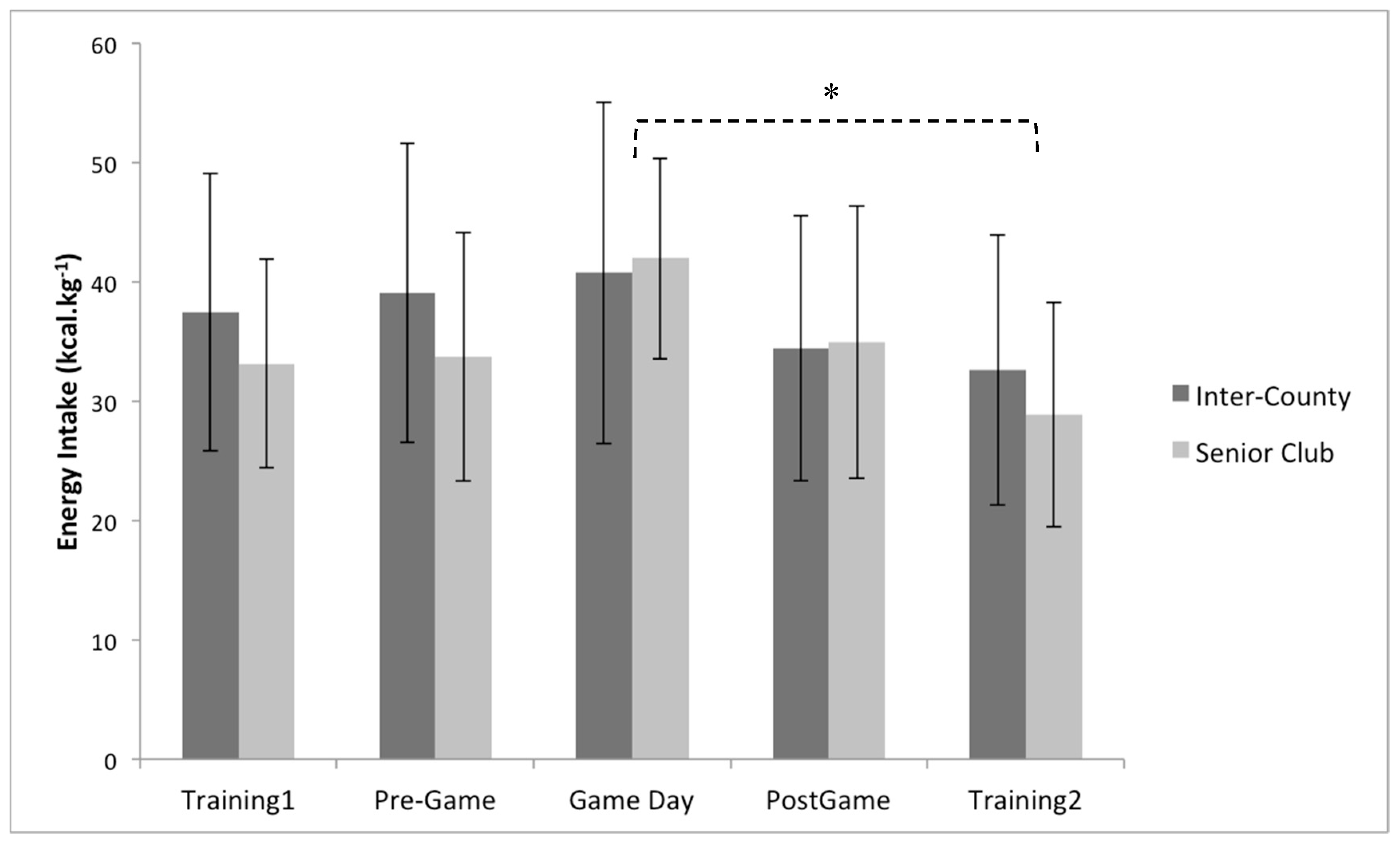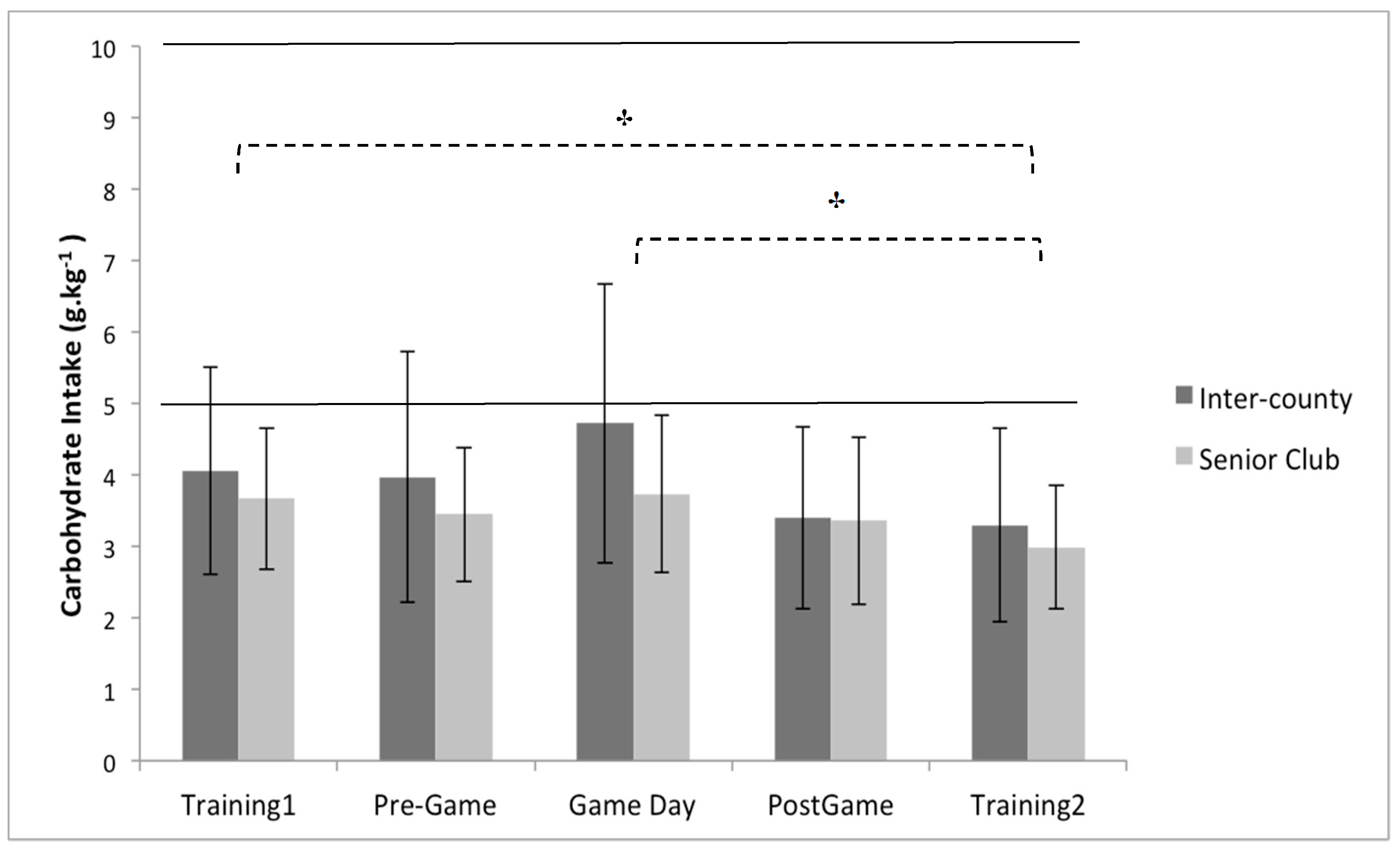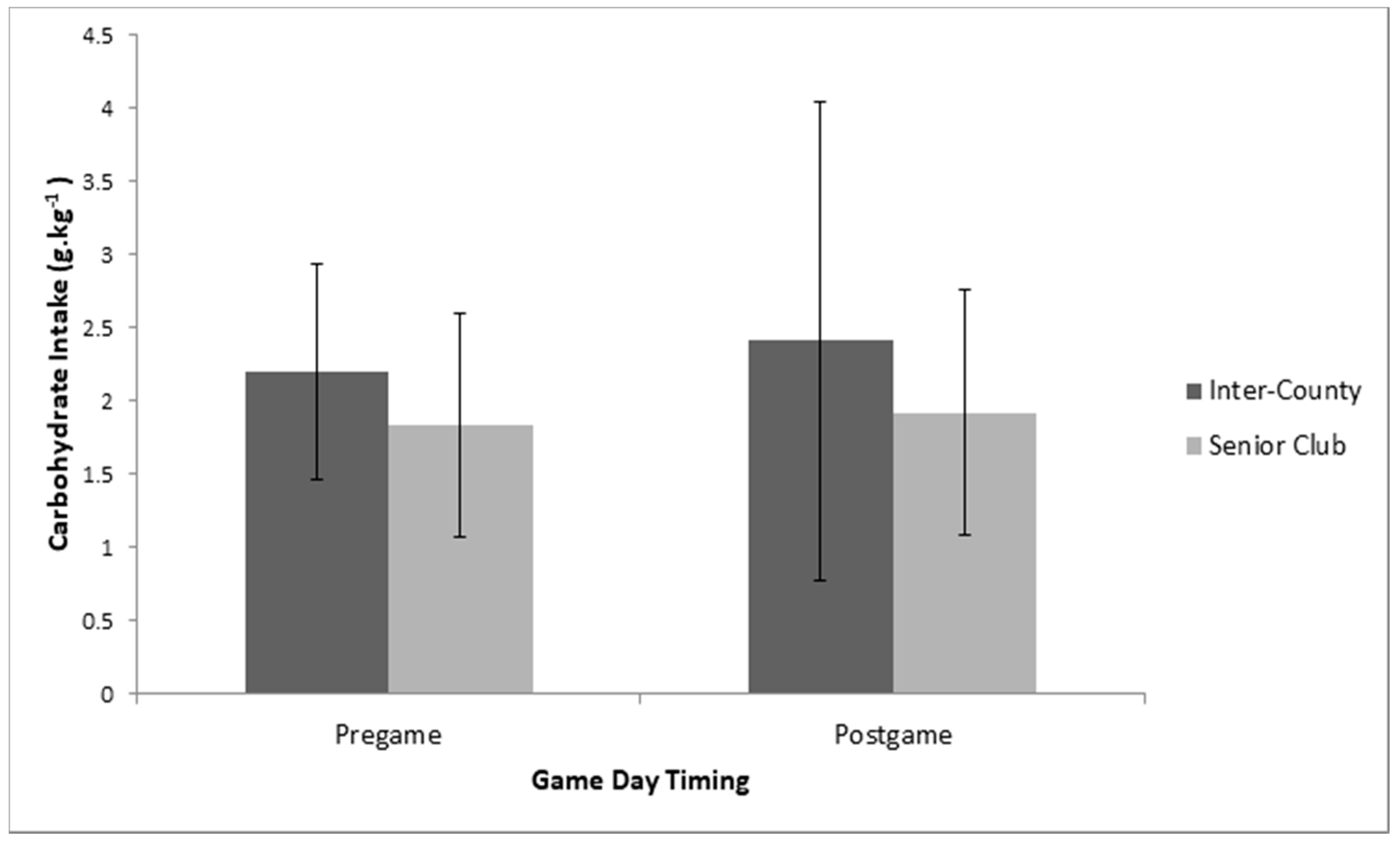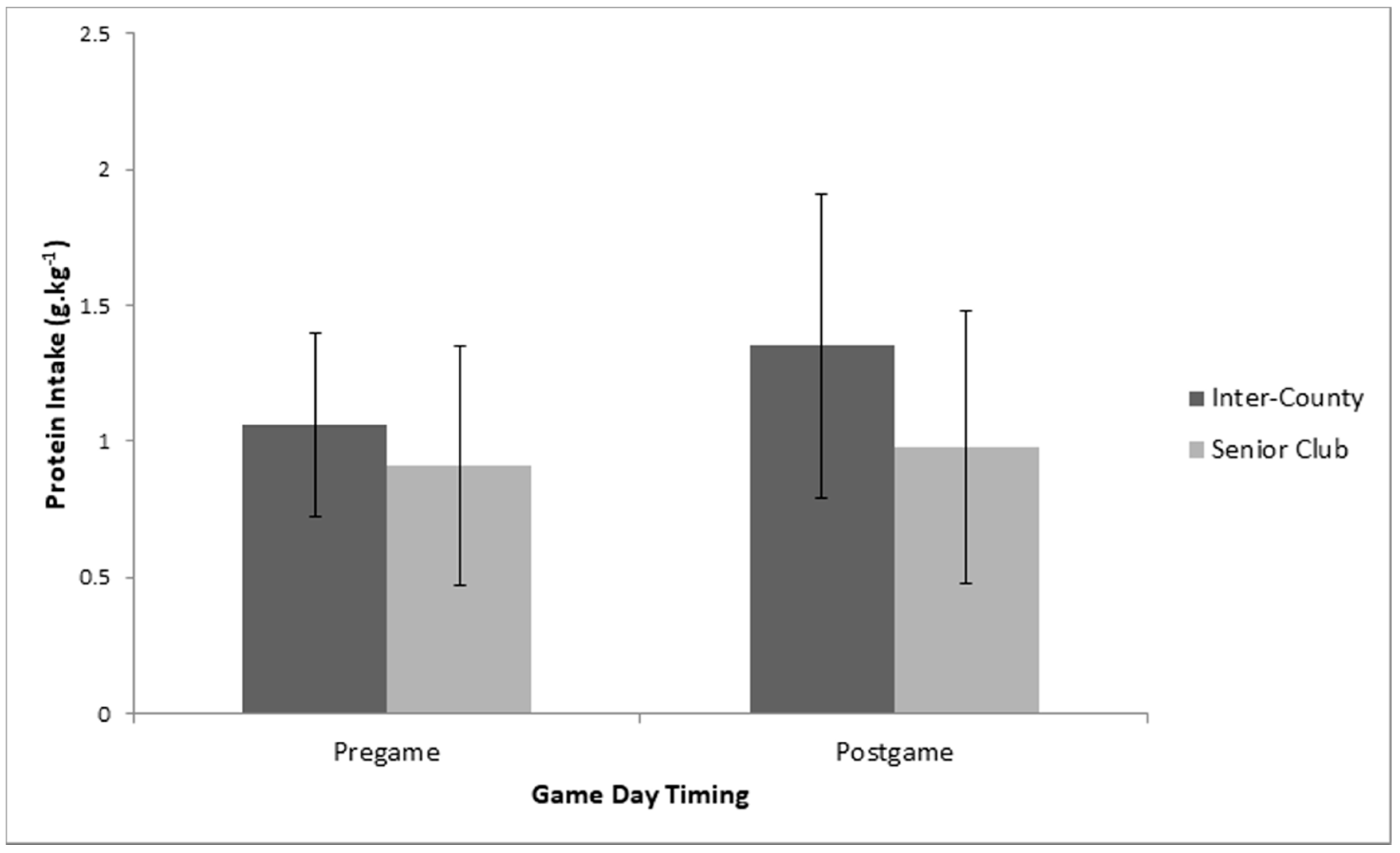Dietary Intake of Gaelic Football Players during Game Preparation and Recovery
Abstract
1. Introduction
2. Materials and Methods
2.1. Participants and Study Design
2.2. Anthropometrics
2.3. Dietary Records
2.4. Statistical Analysis
3. Results
3.1. Participant Characteristics and Mean Dietary Intake
3.2. Dietary Intake: Comparison of Days and Playing Level
3.3. Comarison of Pre-Game Intake and Post-Game Intake on Game Day
4. Discussion
Author Contributions
Funding
Conflicts of Interest
References
- Cassidy, C.; Collins, K.; Shortall, M. The Pre-Competition Macronutrient Intake of Elite Gaelic Football Players. Int. J. Sport Nutr. Exerc. Metab. 2018, 28, 574–579. [Google Scholar] [CrossRef] [PubMed]
- Reilly, B.; Akubat, I.; Lyons, M.; Collins, D.K. Match-Play Demands of Elite Youth Gaelic Football using Global Positioning System Tracking. J. Strength Cond. Res. 2015, 29, 989–996. [Google Scholar] [CrossRef] [PubMed]
- Beasley, K.J. Nutrition and Gaelic Football: Review, Recommendations, and Future Considerations. Int. J. Sport Nutr. Exerc. Metab. 2015, 25, 1–13. [Google Scholar] [CrossRef] [PubMed]
- Reilly, T.; Keane, S. 13 Seasonal Variations in the Fitness of Elite Gaelic Footballers. In Science and Football IV; Routledge: London, UK, 2001; Volume 4, p. 86. [Google Scholar]
- Davies, R.W.; Toomey, C.; McCormack, W.; Hughes, K.; Cremona, A.; Jakeman, P. Body Composition Analysis of Inter-County Gaelic Athletic Association Players Measured by Dual Energy X-Ray Absorptiometry. J. Sports Sci. 2016, 34, 1015–1020. [Google Scholar] [CrossRef] [PubMed]
- Collins, D.; Solan, B.; Doran, D. A Preliminary Investigation into High-Intensity Activity during Elite Gaelic Football. J Sports Ther. 2013, 10, 1–5. [Google Scholar]
- Malone, S.; Solan, B.; Collins, K.D.; Doran, D.A. Positional Match Running Performance in Elite Gaelic Football. J. Strength Cond. Res. 2016, 30, 2292–2298. [Google Scholar] [CrossRef]
- Austin, D.J.; Kelly, S.J. Positional Differences in Professional Rugby League Match Play through the use of Global Positioning Systems. J. Strength Cond. Res. 2013, 27, 14–19. [Google Scholar] [CrossRef]
- Arrones, L.S.; Torreno, N.; Requena, B.; De Villarreal, E.; Casamichana, D.; Carlos, J.; Barbero-Alvarez, D.M. Match-Play Activity Profile in Professional Soccer Players during Official Games and the Relationship between External and Internal Load. J. Sports Med. Phys. Fit. 2014, 55, 1417–1422. [Google Scholar]
- Keane, S.; Reilly, T.; Hughes, M. Analysis of Work-Rates in Gaelic Football. Aust. J. Sci. Med. Sport 1993, 25, 100. [Google Scholar]
- McErlean, C.; Cassidy, J.; O’Donoghue, P. Time-Motion Analysis of Gender and Positional Effects on Work-Rate in Elite Gaelic Football Competition. J. Hum. Mov. Stud. 2000, 38, 269–286. [Google Scholar]
- Malone, S.; Solan, B.; Collins, K.; Doran, D. The Metabolic Power and Energetic Demands of Elite Gaelic Football Match Play. J. Sports Med. Phys. Fit. 2017, 57, 543–549. [Google Scholar]
- Burke, L.M.; Hawley, J.A.; Wong, S.H.; Jeukendrup, A.E. Carbohydrates for Training and Competition. J. Sports Sci. 2011, 29, S17–S27. [Google Scholar] [CrossRef]
- O’Brien, L.; Collins, K.; Doran, D.; Khaiyat, O.; Amirabdollahian, F. Dietary Intake and Energy Expenditure Assessed during a Pre-Season Period in Elite Gaelic Football Players. Sports 2019, 7, 62. [Google Scholar] [CrossRef] [PubMed]
- Reeves, S.; Collins, K. The Nutritional and Anthropometric Status of Gaelic Football Players. Int. J. Sport Nutr. Exerc. Metab. 2003, 13, 539–548. [Google Scholar] [CrossRef] [PubMed]
- Burke, L.M.; Kiens, B.; Ivy, J.L. Carbohydrates and Fat for Training and Recovery. J. Sports Sci. 2004, 22, 15–30. [Google Scholar] [CrossRef]
- Tooley, E.; Bitcon, M.; Briggs, M.; West, D.; Russell, M. Estimates of Energy Intake and Expenditure in Professional Rugby League Players. Int. J. Sports Sci. Coach. 2015, 10, 551–560. [Google Scholar] [CrossRef]
- Howarth, K.R.; Phillips, S.M.; MacDonald, M.J.; Richards, D.; Moreau, N.A.; Gibala, M.J. Effect of Glycogen Availability on Human Skeletal Muscle Protein Turnover during Exercise and Recovery. J. Appl. Physiol. 2010, 109, 431–438. [Google Scholar] [CrossRef]
- Thomas, D.T.; Erdman, K.A.; Burke, L.M. Position of the Academy of Nutrition and Dietetics, Dietitians of Canada, and the American College of Sports Medicine: Nutrition and Athletic Performance. J. Acad. Nutr. Diet. 2016, 116, 501–528. [Google Scholar] [CrossRef]
- Russell, M.; Pennock, A. Dietary Analysis of Young Professional Soccer Players for 1 Week during the Competitive Season. J. Strength Cond. Res. 2011, 25, 1816–1823. [Google Scholar] [CrossRef]
- Devlin, B.L.; Leveritt, M.D.; Kingsley, M.; Belski, R. Dietary Intake, Body Composition, and Nutrition Knowledge of Australian Football and Soccer Players: Implications for Sports Nutrition Professionals in Practice. Int. J. Sport Nutr. Exerc. Metab. 2017, 27, 130–138. [Google Scholar] [CrossRef]
- Brunner, E.; Juneja, M.; Marmot, M. Dietary Assessment in Whitehall II: Comparison of 7 D Diet Diary and Food-Frequency Questionnaire and Validity Against Biomarkers. Br. J. Nutr. 2001, 86, 405–414. [Google Scholar] [CrossRef] [PubMed]
- Bingham, S.A.; Gill, C.; Welch, A.; Day, K.; Cassidy, A.; Khaw, K.; Sneyd, M.; Key, T.; Roe, L.; Day, N. Comparison of Dietary Assessment Methods in Nutritional Epidemiology: Weighed Records V. 24 H Recalls, Food-Frequency Questionnaires and Estimated-Diet Records. Br. J. Nutr. 1994, 72, 619–643. [Google Scholar] [CrossRef] [PubMed]
- Barrett-Connor, E. Nutrition Epidemiology: How do we Know what they Ate? Am. J. Clin. Nutr. 1991, 54, 182S–187S. [Google Scholar] [CrossRef] [PubMed]
- Edington, J.; Thorogood, M.; Geekie, M.; Ball, M.; Mann, J. Assessment of Nutritional Intake using Dietary Records with Estimated Weights. J. Hum. Nutr. Diet. 1989, 2, 407–414. [Google Scholar] [CrossRef]
- Yuan, C.; Spiegelman, D.; Rimm, E.B.; Rosner, B.A.; Stampfer, M.J.; Barnett, J.B.; Chavarro, J.E.; Subar, A.F.; Sampson, L.K.; Willett, W.C. Validity of a Dietary Questionnaire Assessed by Comparison with Multiple Weighed Dietary Records or 24-Hour Recalls. Am. J. Epidemiol. 2017, 185, 570–584. [Google Scholar] [CrossRef]
- Lentjes, M.A.; McTaggart, A.; Mulligan, A.A.; Powell, N.A.; Parry-Smith, D.; Luben, R.N.; Bhaniani, A.; Welch, A.A.; Khaw, K. Dietary Intake Measurement using 7 D Diet Diaries in British Men and Women in the European Prospective Investigation into Cancer-Norfolk Study: A Focus on Methodological Issues. Br. J. Nutr. 2014, 111, 516–526. [Google Scholar] [CrossRef]
- Costello, N.; Deighton, K.; Dyson, J.; Mckenna, J.; Jones, B. Snap-N-Send: A Valid and Reliable Method for Assessing the Energy Intake of Elite Adolescent Athletes. Eur. J. Sport Sci. 2017, 17, 1044–1055. [Google Scholar] [CrossRef]
- Black, A.E. Critical Evaluation of Energy Intake using the Goldberg Cut-Off for Energy Intake: Basal Metabolic Rate. A Practical Guide to its Calculation, use and Limitations. Int. J. Obes. 2000, 24, 1119–1130. [Google Scholar] [CrossRef]
- Goldberg, G.R.; Black, A.E.; Jebb, S.A.; Cole, T.J.; Murgatroyd, P.R.; Coward, W.A.; Prentice, A.M. Critical Evaluation of Energy Intake Data using Fundamental Principles of Energy Physiology: 1. Derivation of Cut-Off Limits to Identify Under-Recording. Eur. J. Clin. Nutr. 1991, 45, 569–581. [Google Scholar]
- Harris, J.A.; Benedict, F.G. A Biometric Study of Human Basal Metabolism. Proc. Natl. Acad. Sci. USA 1918, 4, 370–373. [Google Scholar] [CrossRef]
- Burke, L.; Deakin, V. Clinical Sports Nutrition; McGraw-Hill: Sydney, Australia, 1994. [Google Scholar]
- Anderson, L.; Orme, P.; Naughton, R.J.; Close, G.L.; Milsom, J.; Rydings, D.; O’boyle, A.; Di Michele, R.; Louis, J.; Hambly, C. Energy Intake and Expenditure of Professional Soccer Players of the English Premier League: Evidence of Carbohydrate Periodization. Int. J. Sport Nutr. Exerc. Metab. 2017, 27, 228–238. [Google Scholar] [CrossRef] [PubMed]
- Bradley, W.J.; Cavanagh, B.; Douglas, W.; Donovan, T.F.; Twist, C.; Morton, J.P.; Close, G.L. Energy Intake and Expenditure Assessed ‘in-Season’in an Elite European Rugby Union Squad. Eur. J. Sport Sci. 2015, 15, 469–479. [Google Scholar] [CrossRef] [PubMed]
- Burke, L. Fueling Strategies to Optimize Performance: Training High or Training Low? Scand. J. Med. Sci. Sports 2010, 20, 48–58. [Google Scholar] [CrossRef] [PubMed]
- McInerney, P.; Lessard, S.J.; Burke, L.M.; Coffey, V.G.; Lo Giudice, S.L.; Southgate, R.J.; Hawley, J.A. Failure to Repeatedly Supercompensate Muscle Glycogen Stores in Highly Trained Men. Med. Sci. Sports Exerc. 2005, 37, 404–411. [Google Scholar] [CrossRef]
- Balsom, P.; Wood, K.; Olsson, P.; Ekblom, B. Carbohydrate Intake and Multiple Sprint Sports: With Special Reference to Football (Soccer). Int. J. Sports Med. 1999, 20, 48–52. [Google Scholar] [CrossRef]
- Åkermark, C.; Jacobs, I.; Rasmusson, M.; Karlsson, J. Diet and Muscle Glycogen Concentration in Relation to Physical Performance in Swedish Elite Ice Hockey Players. Int. J. Sport Nutr. Exerc. Metab. 1996, 6, 272–284. [Google Scholar] [CrossRef] [PubMed]
- Ivy, J.L.; Katz, A.L.; Cutler, C.L.; Sherman, W.M.; Coyle, E.F. Muscle Glycogen Synthesis after Exercise: Effect of Time of Carbohydrate Ingestion. J. Appl. Physiol. 1988, 64, 1480–1485. [Google Scholar] [CrossRef]
- Hulston, C.J.; Venables, M.C.; Mann, C.H.; Martin, C.; Philp, A.; Baar, K.; Jeukendrup, A.E. Training with Low Muscle Glycogen Enhances Fat Metabolism in Well-Trained Cyclists. Med. Sci. Sports Exerc. 2010, 42, 2046–2055. [Google Scholar] [CrossRef]
- Yeo, W.K.; McGee, S.L.; Carey, A.L.; Paton, C.D.; Garnham, A.P.; Hargreaves, M.; Hawley, J.A. Acute Signalling Responses to Intense Endurance Training Commenced with Low or Normal Muscle Glycogen. Exp. Physiol. 2010, 95, 351–358. [Google Scholar] [CrossRef]
- Bartlett, J.D.; Hawley, J.A.; Morton, J.P. Carbohydrate Availability and Exercise Training Adaptation: Too Much of a Good Thing? Eur. J. Sport Sci. 2015, 15, 3–12. [Google Scholar] [CrossRef]
- Gleeson, M.; Nieman, D.C.; Pedersen, B.K. Exercise, Nutrition and Immune Function. J. Sports Sci. 2004, 22, 115–125. [Google Scholar] [CrossRef] [PubMed]
- Cox, G.R.; Clark, S.A.; Cox, A.J.; Halson, S.L.; Hargreaves, M.; Hawley, J.A.; Jeacocke, N.; Snow, R.J.; Yeo, W.K.; Burke, L.M. Daily Training with High Carbohydrate Availability Increases Exogenous Carbohydrate Oxidation during Endurance Cycling. J. Appl. Physiol. 2010, 109, 126–134. [Google Scholar] [CrossRef]
- Jäger, R.; Kerksick, C.M.; Campbell, B.I.; Cribb, P.J.; Wells, S.D.; Skwiat, T.M.; Purpura, M.; Ziegenfuss, T.N.; Ferrando, A.A.; Arent, S.M. International Society of Sports Nutrition Position Stand: Protein and Exercise. J. Int. Soc. Sports Nutr. 2017, 14, 20. [Google Scholar] [CrossRef] [PubMed]
- Tipton, K.D.; Elliott, T.A.; Cree, M.G.; Wolf, S.E.; Sanford, A.P.; Wolfe, R.R. Ingestion of Casein and Whey Proteins Result in Muscle Anabolism After Resistance Exercise. Med. Sci. Sports Exerc. 2004, 36, 2073–2081. [Google Scholar] [CrossRef] [PubMed]
- Cockburn, E.; Hayes, P.R.; French, D.N.; Stevenson, E.; St Clair Gibson, A. Acute Milk-Based protein–CHO Supplementation Attenuates Exercise-Induced Muscle Damage. Appl. Physiol. Nutr. Metab. 2008, 33, 775–783. [Google Scholar] [CrossRef] [PubMed]
- Rowlands, D.S.; Rössler, K.; Thorp, R.M.; Graham, D.F.; Timmons, B.W.; Stannard, S.R.; Tarnopolsky, M.A. Effect of Dietary Protein Content during Recovery from High-Intensity Cycling on Subsequent Performance and Markers of Stress, Inflammation, and Muscle Damage in Well-Trained Men. Appl. Physiol. Nutr. Metab. 2007, 33, 39–51. [Google Scholar] [CrossRef] [PubMed]
- Mettler, S.; Mitchell, N.; Tipton, K.D. Increased Protein Intake Reduces Lean Body Mass Loss during Weight Loss in Athletes. Med. Sci. Sports Exerc. 2010, 42, 326–337. [Google Scholar] [CrossRef]
- Egan, B. Protein Intake for Athletes and Active Adults: Current Concepts and Controversies. Nutr. Bull. 2016, 41, 202–213. [Google Scholar] [CrossRef]
- de Oliveira, E.P.; Burini, R.C.; Jeukendrup, A. Gastrointestinal Complaints during Exercise: Prevalence, Etiology, and Nutritional Recommendations. Sports Med. 2014, 44, 79–85. [Google Scholar] [CrossRef]
- Jeukendrup, A.E. Training the Gut for Athletes. Sports Med. 2017, 47, 101–110. [Google Scholar] [CrossRef]
- Burke, L.M.; Read, R.S. A Study of Dietary Patterns of Elite Australian Football Players. Can. J. Sport Sci. 1988, 13, 15–19. [Google Scholar] [PubMed]
- Burke, L.M.; Collier, G.R.; Broad, E.M.; Davis, P.G.; Martin, D.T.; Sanigorski, A.J.; Hargreaves, M. Effect of Alcohol Intake on Muscle Glycogen Storage After Prolonged Exercise. J. Appl. Physiol. 2003, 95, 983–990. [Google Scholar] [CrossRef] [PubMed]
- Barnes, M.J.; Mündel, T.; Stannard, S.R. Acute Alcohol Consumption Aggravates the Decline in Muscle Performance Following Strenuous Eccentric Exercise. J. Sci. Med. Sport 2010, 13, 189–193. [Google Scholar] [CrossRef] [PubMed]
- O’Brien, C.P.; Lyons, F. Alcohol and the Athlete. Sports Med. 2000, 29, 295–300. [Google Scholar] [CrossRef]
- Bingham, S.A. Limitations of the various Methods for Collecting Dietary Intake Data. Ann. Nutr. Metab. 1991, 35, 117–127. [Google Scholar] [CrossRef]
- Magkos, F.; Yannakoulia, M. Methodology of Dietary Assessment in Athletes: Concepts and Pitfalls. Curr. Opin. Clin. Nutr. Metab. Care 2003, 6, 539–549. [Google Scholar] [CrossRef]
- Drenowatz, C.; Eisenmann, J.C.; Carlson, J.J.; Pfeiffer, K.A.; Pivarnik, J.M. Energy Expenditure and Dietary Intake during High-Volume and Low-Volume Training Periods among Male Endurance Athletes. Appl. Physiol. Nutr. Metab. 2012, 37, 199–205. [Google Scholar] [CrossRef]
- Ebine, N.; Rafamantanantsoa, H.H.; Nayuki, Y.; Yamanaka, K.; Tashima, K.; Ono, T.; Saitoh, S.; Jones, P.J. Measurement of Total Energy Expenditure by the Doubly Labelled Water Method in Professional Soccer Players. J. Sports Sci. 2002, 20, 391–397. [Google Scholar] [CrossRef]
- Hill, R.; Davies, P. The Validity of Self-Reported Energy Intake as Determined using the Doubly Labelled Water Technique. Br. J. Nutr. 2001, 85, 415–430. [Google Scholar] [CrossRef]
- Morehen, J.C.; Bradley, W.J.; Clarke, J.; Twist, C.; Hambly, C.; Speakman, J.R.; Morton, J.P.; Close, G.L. The Assessment of Total Energy Expenditure during a 14-Day in-Season Period of Professional Rugby League Players using the Doubly Labelled Water Method. Int. J. Sport Nutr. Exerc. Metab. 2016, 26, 464–472. [Google Scholar] [CrossRef]





| Food Diary Day | Data Label | Description |
|---|---|---|
| Day 1 | Training 1 | Light Intensity Pitch Session |
| Day 2 | Pre-game | Rest |
| Day 3 | Game day | Mid-Afternoon Game |
| Day 4 | Post-game | Rest |
| Day 5 | Training 2 | Medium-Intensity Pitch Session |
| Characteristics | Inter-County (n = 19) | Senior Club (n = 14) | Total (n = 33) |
|---|---|---|---|
| Height (m) | 1.80 ± 0.05 | 1.81 ± 0.05 | 1.81 ± 0.05 |
| Mass (kg) | 82.9 ± 6.5 | 81.5 ± 8 | 82.3 ± 7.1 |
| Age (Years) | 24 ± 3.8 | 25.9 ± 5.9 | 24.8 ± 4.9 |
| BMI | 25.5 ± 1.6 | 24.8 ± 2.6 | 25.2 ± 2.1 |
| BMR (kcal) | 1947 ± 102 | 1919 ± 103 | 1935 ± 102 |
| Mean EI | 3038 ± 726 | 2802 ± 421 | 2938 ± 618 |
| EI: BMR | 1.6 ± 0.4 | 1.5 ± 0.2 | 1.5 ± 0.3 |
| Macronutrient | Dietary Intake | Sports Nutrition Recommendations | |
|---|---|---|---|
| Carbohydrate | g.kg−1 Body Mass | 3.7 ± 1.4 | 5–10 g.kg−1 per day |
| % Total Energy Intake | 41.3 ± 1.7 | ||
| Protein | g.kg−1 Body Mass | 2.0 ± 0.7 | 1.2–2 g.kg−1 per day |
| % Total Energy Intake | 22.6 ± 1.4 | ||
| Fat | g.kg−1 Body Mass | 1.3 ± 0.6 | 20–35% Total Energy Intake |
| % Total Energy Intake | 33.4 ± 4.2 | ||
© 2020 by the authors. Licensee MDPI, Basel, Switzerland. This article is an open access article distributed under the terms and conditions of the Creative Commons Attribution (CC BY) license (http://creativecommons.org/licenses/by/4.0/).
Share and Cite
Ó Catháin, C.; Fleming, J.; Renard, M.; Kelly, D.T. Dietary Intake of Gaelic Football Players during Game Preparation and Recovery. Sports 2020, 8, 62. https://doi.org/10.3390/sports8050062
Ó Catháin C, Fleming J, Renard M, Kelly DT. Dietary Intake of Gaelic Football Players during Game Preparation and Recovery. Sports. 2020; 8(5):62. https://doi.org/10.3390/sports8050062
Chicago/Turabian StyleÓ Catháin, Ciarán, James Fleming, Michèle Renard, and David T. Kelly. 2020. "Dietary Intake of Gaelic Football Players during Game Preparation and Recovery" Sports 8, no. 5: 62. https://doi.org/10.3390/sports8050062
APA StyleÓ Catháin, C., Fleming, J., Renard, M., & Kelly, D. T. (2020). Dietary Intake of Gaelic Football Players during Game Preparation and Recovery. Sports, 8(5), 62. https://doi.org/10.3390/sports8050062







